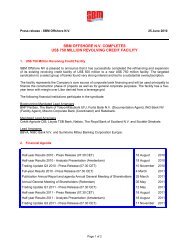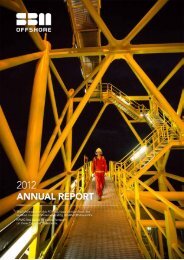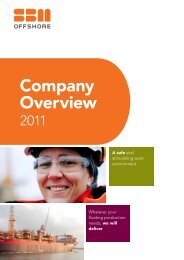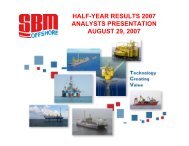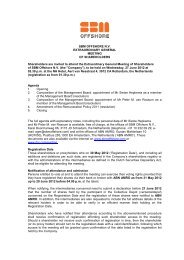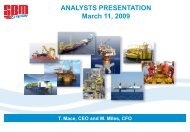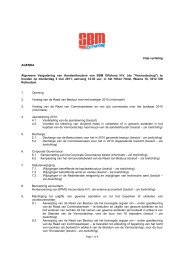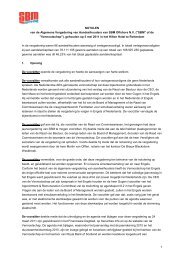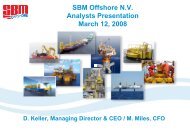Annual Report 2010 - SBM Offshore
Annual Report 2010 - SBM Offshore
Annual Report 2010 - SBM Offshore
You also want an ePaper? Increase the reach of your titles
YUMPU automatically turns print PDFs into web optimized ePapers that Google loves.
Share based payments<br />
Within the Company there are four types of share<br />
based payments: share option plan (until 2008), RSU/<br />
PSU (as of 2009), performance shares and matching<br />
bonus shares. All types of share based payments<br />
qualify as equity settled plans.<br />
The estimated total amount to be expensed over the<br />
vesting period related to share based payments is<br />
determined by reference to the fair value of the instruments<br />
determined at the grant date, excluding the<br />
impact of any non-market vesting conditions. Non<br />
market-vesting conditions are included in assumptions<br />
about the number of options that are expected<br />
to become exercisable or the number of shares that<br />
the employee will ultimately receive. Main assumptions<br />
for estimates are revised at balance sheet date. Total<br />
cost for the period is charged or credited to the income<br />
statement, with a corresponding adjustment to equity.<br />
The proceeds received on exercise of the options net<br />
of any directly attributable costs are credited to equity.<br />
Fair value of share options is calculated using the average<br />
of the Black & Scholes and binomial valuation<br />
models.<br />
When equity instruments are exercised the Company<br />
issues new shares.<br />
Provisions<br />
General<br />
A provision is recognised in the balance sheet when the<br />
Company has a present legal or constructive obligation<br />
as a result of a past event, it is probable that an outflow<br />
of economic benefits will be required to settle the<br />
obligation, and the amount has been reliably estimated.<br />
If the effect is material, provisions are determined by<br />
discounting the expected future cash flows at a pre<br />
tax rate that reflects current market assessments of<br />
the time value of money and, when appropriate, the<br />
risk specific to the liability. Subsequently, the interest<br />
accrued on discounted provisions will be recognised<br />
as financial expenses. Discounting of provisions mainly<br />
concerns fleet demobilisation obligations.<br />
Reorganisation<br />
Provisions for reorganisation costs relate to costs for<br />
termination of employment and onerous contracts.<br />
Financial Review / Financial Statements <strong>2010</strong><br />
Demobilisation obligations<br />
The provision for demobilisation obligations relates<br />
to estimated costs for demobilisation of leased facilities<br />
at the end of the respective lease period. The net<br />
present value of the future obligations is included in<br />
property, plant and equipment with a corresponding<br />
amount included in the provision for demobilisation. As<br />
the remaining duration of each lease reduces, and the<br />
discounting effect on the provision unwinds, accrued<br />
interest is recognised as part of financial expenses and<br />
added to the provision.<br />
Offsetting Financial Instruments<br />
Financial assets and liabilities are offset and the net<br />
amount reported in the balance sheet when there is<br />
a legally enforceable right to offset the recognised<br />
amounts and there is an intention to settle on a net<br />
basis, or realise the asset and settle the liability<br />
simultaneously.<br />
Revenue<br />
Revenue is shown net of value-added tax, returns,<br />
rebates and discounts and after eliminating sales within<br />
the group.<br />
Construction work in progress<br />
As soon as the outcome of a construction contract can<br />
be estimated reliably, contract revenue and expenses<br />
are recognised in the income statement using the<br />
‘percentage-of-completion method’. The stage of<br />
completion is measured by reference to the total cost<br />
incurred up to the end of the reporting period as a percentage<br />
of the total estimated cost for each contract,<br />
unless the physical progress significantly differs. An<br />
expected loss on a contract is recognised immediately<br />
in the income statement.<br />
Variations in contract work, claims and incentive payments<br />
are included in the contract revenue to the<br />
extent negotiations with the customer are sufficiently<br />
advanced and it is probable that the outcome can be<br />
reliably measured.<br />
Lease and operate contracts<br />
Turnover (the total of the earned day-rates) of long-term<br />
operating lease and operate contracts are reported<br />
annually on a straight-line basis over the period of the<br />
<strong>SBM</strong> <strong>Offshore</strong> – <strong>Annual</strong> <strong>Report</strong> <strong>2010</strong> 125



